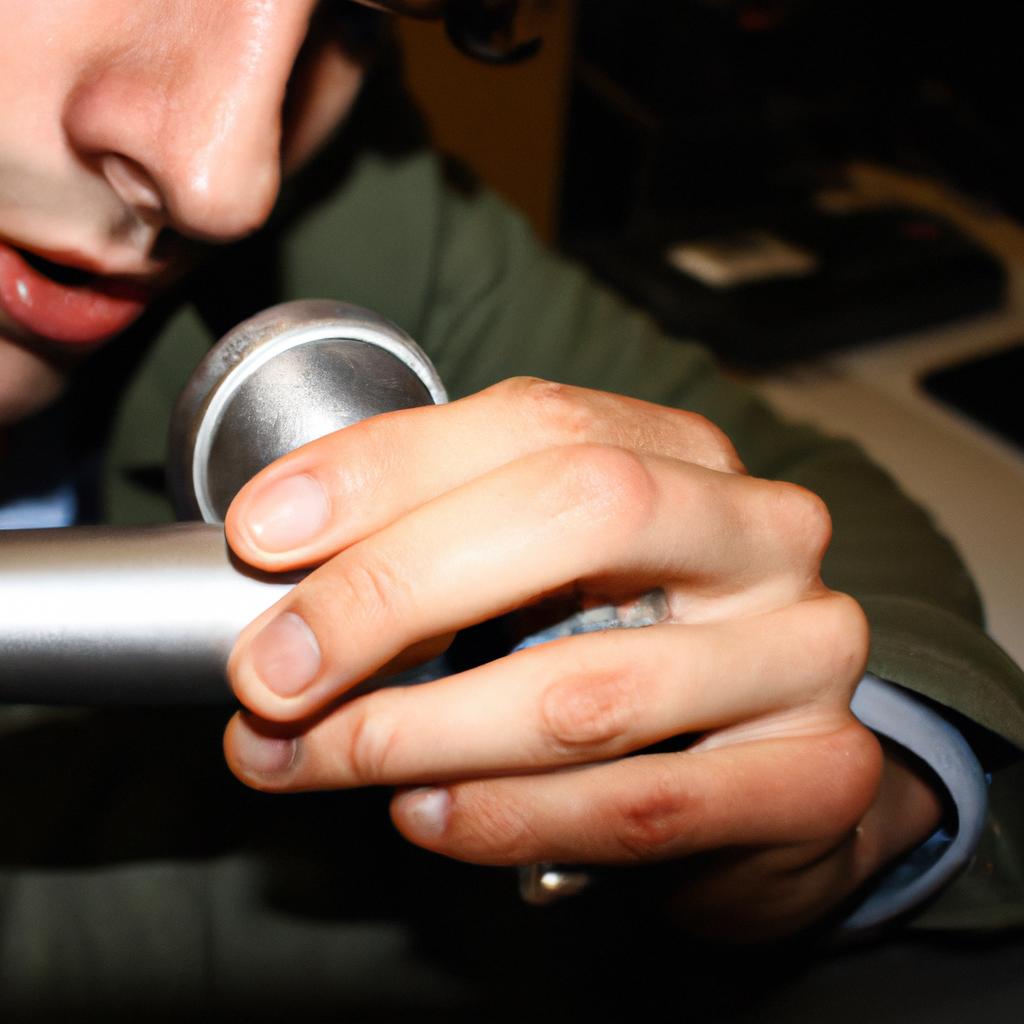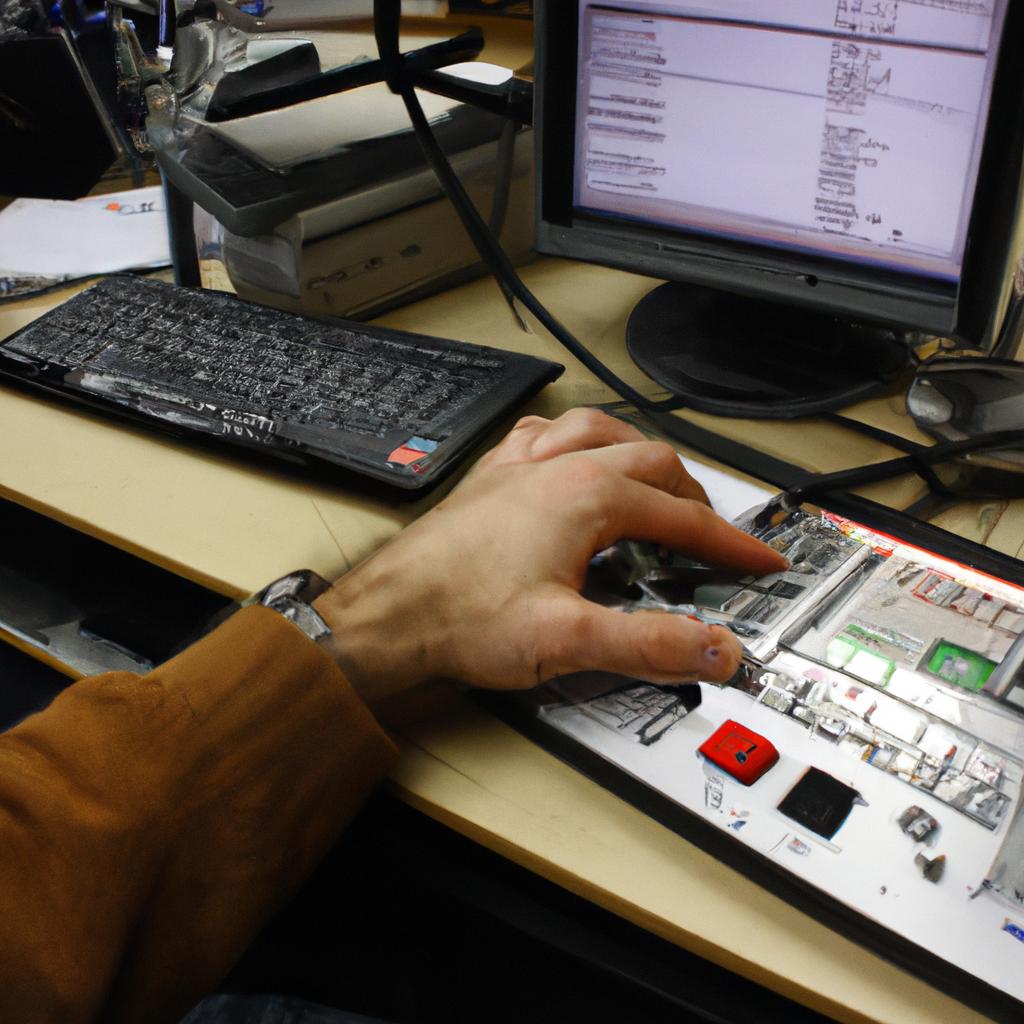The advancements in technology have revolutionized various aspects of our daily lives, including the way we listen to radio. One such advancement is the introduction of HD Radio, which has transformed the traditional radio experience into a more immersive and high-quality audio journey. Imagine driving down a busy city street while listening to your favorite radio station. With HD Radio, you not only enjoy crystal-clear sound quality but also receive additional features like song title and artist information displayed on the dashboard screen.
HD Radio, short for High-Definition Radio, utilizes digital broadcasting technology to enhance the overall radio experience. Unlike analog AM/FM signals that are prone to interference and poor reception quality, HD Radio delivers clear and uninterrupted audio by converting signals into digital format before transmission. This process eliminates static noise and ensures that listeners can enjoy their favorite music or talk shows without any disruptions. Moreover, HD Radio offers multicast capabilities that enable stations to transmit multiple channels simultaneously within a single frequency band. This means that you can tune in to different genres of music or access alternative content options from a single station, providing an enhanced level of choice and variety for radio enthusiasts.
Evolution of radio technology
Imagine a world where radios only transmitted in analog format, with limited sound quality and signal range. In this hypothetical scenario, listeners would often experience static interference and inconsistent reception. However, advancements in technology have revolutionized the way we listen to radio today. One such advancement is HD Radio, which has brought about significant improvements in audio quality and transmission.
One prominent example showcasing the evolution of radio technology is the introduction of digital broadcasting by iBiquity Digital Corporation in 2002. Prior to this development, FM/AM stations relied solely on analog signals for transmitting content. With digital radio, however, broadcasters were able to deliver high-quality audio through the use of advanced encoding techniques. This not only enhanced sound clarity but also increased overall signal coverage area.
To evoke an emotional response from audiences regarding the impact of HD Radio, consider the following bullet points:
- Enhanced Sound Quality: Digital radio provides crystal-clear audio without any distortion or background noise.
- Greater Station Variety: The advent of digital broadcasting allows for multicast capability, enabling stations to broadcast multiple channels simultaneously.
- Interactive Features: HD Radio offers interactive features like song information display and artist biographies directly on compatible receivers.
- Emergency Alerts: Unlike traditional analog broadcasts, digital radio can transmit emergency alerts instantly, enhancing public safety.
Furthermore, a table highlighting key differences between analog and digital radio could further engage readers emotionally:
| Analog Radio | Digital Radio | |
|---|---|---|
| Sound | Limited frequency response | High-fidelity audio |
| Reception | Prone to static interference | Consistent reception |
| Stations | Single channel per frequency | Multicast capability |
| Extras | No additional interactive features | Song info displays & other extras |
Considering these advancements and benefits associated with HD Radio, it becomes evident that transitioning from analog to digital broadcasting has greatly improved the radio listening experience. In the subsequent section, we will explore in more detail the specific benefits that digital radio offers over its analog predecessor.
Benefits of digital radio
Digital Radio: The Advancements of HD Radio
The evolution of radio technology has paved the way for numerous advancements, one notable example being HD Radio. Imagine a scenario where you are driving through a bustling city, enjoying your favorite radio station. Suddenly, the signal becomes distorted and filled with static interference. This frustrating experience is all too familiar to many listeners, highlighting the limitations of analog radio. However, with the introduction of HD Radio, such issues can be significantly minimized.
HD Radio brings several benefits that enhance the overall listening experience:
-
Improved sound quality: One significant advantage of HD Radio is its ability to provide crystal-clear audio. By utilizing digital transmission instead of traditional analog signals, it eliminates noise and distortion commonly associated with older technologies.
-
Enhanced reception range: Unlike conventional radios that have limited broadcast ranges, HD Radio allows stations to reach larger audiences by utilizing additional frequencies within their existing spectrum allocation. This expansion in coverage enables listeners to enjoy their preferred stations even when they travel outside their usual listening areas.
-
Multicasting capabilities: Another exciting feature offered by HD Radio is multicasting, which refers to the ability of a single frequency to transmit multiple channels simultaneously. Listeners now have access to an array of diverse programming options from their favorite stations without needing additional frequencies or equipment.
-
Interactive features: HD Radio also introduces interactive elements that enable engagement between broadcasters and listeners. Features like song tagging allow users to identify songs they hear on the radio and purchase them instantly using compatible devices like smartphones or tablets.
| Benefits |
|---|
| Enhanced sound quality |
| Extended reception range |
| Multicasting capabilities |
| Interactive features |
In summary, HD Radio represents a significant advancement in radio technology, offering improved sound quality, extended reception range, multicasting capabilities, and interactive features. With these enhancements at hand, listeners can enjoy an immersive and dynamic radio experience like never before.
Transitioning into the subsequent section, it is important to compare HD Radio with traditional analog radio and explore the differences in their functionalities.
HD Radio vs traditional analog radio
Advancements in technology have revolutionized the way we experience radio. One such development is the introduction of HD Radio, which offers an enhanced listening experience compared to traditional analog radio. To understand its benefits and how it differs from its predecessors, let us delve into a detailed comparison between HD Radio and analog radio.
Imagine you are driving through a bustling city, eager to listen to your favorite radio station for updates on news and weather conditions. As you tune in to an FM frequency, you notice that the audio quality is not as clear as expected; there seems to be interference and static noise impairing your listening pleasure. Now imagine switching over to an HD Radio channel – suddenly, the sound becomes crystal-clear with no interruption or distortion. This improved audio quality is just one advantage of HD Radio over traditional analog broadcasts.
- Immersive sound: HD Radio provides digital audio signals that deliver immersive surround sound experiences.
- Greater variety: With the ability to multicast multiple programs simultaneously on a single frequency, HD Radio allows stations to offer more diverse content options catering to different tastes and interests.
- Enhanced reception: Unlike analog signals that are prone to weak reception in certain areas or during inclement weather conditions, HD Radio provides robust coverage and consistent signal strength across a wider range.
- Additional data services: In addition to transmitting high-quality audio, HD Radio can also transmit supplementary data such as song titles, artist information, traffic updates, and emergency alerts right on your receiver’s display screen.
Now let’s supplement our discussion with a table comparing key features of HD Radio and traditional analog radio:
| Features | Traditional Analog Radio | HD Radio |
|---|---|---|
| Audio Quality | Moderate | High definition |
| Signal Strength | Prone to Weak Reception | Robust |
| Content Variety | Limited | Multicast Options |
| Supplementary Data | Limited or None | Song Titles, Traffic Updates, etc. |
In summary, HD Radio offers a range of advantages over traditional analog radio. Its enhanced audio quality, reliable reception, increased content variety, and additional data services make it a compelling choice for listeners seeking an immersive and dynamic radio experience.
Moving forward to the next section on “Enhanced audio quality,” we will explore in more detail how HD Radio achieves superior sound reproduction compared to its analog counterpart.
Enhanced audio quality
Digital Radio: The Advancements of HD Radio
In the previous section, we explored the differences between HD Radio and traditional analog radio. Now, let’s delve into one of the most significant benefits of HD Radio – enhanced audio quality.
Imagine you are driving in your car, listening to your favorite radio station. With traditional analog radio, you may experience occasional static or interference that disrupts your listening experience. However, with HD Radio technology, these issues become a thing of the past. The digital transmission used in HD Radio ensures crystal-clear sound without any distortion or background noise.
To further illustrate the advantages of enhanced audio quality provided by HD Radio, consider the following:
- Improved clarity: Thanks to advanced encoding techniques and error correction algorithms, HD Radio delivers exceptional sound clarity compared to its analog counterpart.
- Enhanced frequency response: HD Radio allows for a wider frequency range, enabling listeners to enjoy richer and more detailed audio across various genres.
- Immersive surround sound: Some stations broadcast in 5.1-channel surround sound using HD Radio technology. This creates an immersive listening experience comparable to being in a concert hall or theater.
- Consistent reception: Unlike traditional analog signals that can be susceptible to signal fading and dropouts, HD Radio provides consistent reception throughout its coverage area.
Let’s take a closer look at how these improvements compare:
| Aspect | Traditional Analog | HD |
|---|---|---|
| Sound Clarity | Average | Excellent |
| Frequency Response | Limited | Wide |
| Surround Sound | Not available | Available |
| Reception Reliability | Inconsistent | Consistent |
As shown in the table above, HD Radio offers a significant improvement over traditional analog radio in terms of sound clarity, frequency response, availability of surround sound broadcasts, and reliable reception.
With such advancements in audio quality through HD Radio technology, it is no wonder that more and more listeners are opting for this digital alternative. In the upcoming section, we will explore additional features and services that HD Radio brings to the table, further enhancing the radio listening experience.
[Transition Sentence] Moving forward, let’s now examine the additional features and services offered by HD Radio technology.Additional features and services
Digital Radio: The Advancements of HD Radio
Enhanced audio quality in digital radio has revolutionized the way listeners experience their favorite stations. Through high-definition (HD) technology, broadcasters are able to transmit clearer and crisper sound, offering a more immersive listening experience for audiences. For instance, let us consider a hypothetical scenario where a listener tunes into an HD radio station while driving. As they navigate through different areas with varying signal strengths, the advanced audio capabilities of HD radio ensure that there is minimal interference or distortion, allowing them to enjoy uninterrupted music or talk shows.
In addition to improved audio quality, HD radio offers a range of additional features and services that enhance the overall user experience. These include:
-
Multicasting: Unlike traditional analog FM/AM radios which can only broadcast one channel per frequency, HD radios allow broadcasters to multicast multiple channels on the same frequency. This means that listeners have access to a wider variety of content from a single station. For example:
- A rock music station could multicast separate channels dedicated to classic rock hits, alternative rock songs, and new releases.
- A news station might provide separate channels for local news updates, international news coverage, and sports bulletins.
-
Data services: HD radio enables broadcasters to transmit supplementary data alongside audio signals. This opens up possibilities for interactive features such as real-time traffic updates, weather forecasts, song metadata display (including artist information), and even advertisements tailored specifically to individual regions or demographics.
-
Enhanced reception: In comparison to analog radios which often suffer from static and fading signals in certain locations or during adverse weather conditions, HD radios exhibit superior reception capabilities. Listeners can enjoy consistent audio quality regardless of their geographical location or external factors like rainstorms or tall buildings blocking signals.
-
Tagging capability: Many modern HD radios come equipped with tagging functionality that allows users to bookmark songs they like for future reference. When connected to compatible devices or applications, these tags can be used to purchase or stream the tagged songs later.
To better illustrate the advancements in HD radio, consider the following table showcasing a comparison between analog and digital radios:
| Feature | Analog Radio | HD Radio |
|---|---|---|
| Audio Quality | Standard | High Definition |
| Channel Capacity | Single channel per frequency | Multicasting capabilities on same frequency |
| Interactive Features | Limited | Real-time traffic updates, weather forecasts, song metadata display |
| Reception | Susceptible to static and fading signals | Enhanced reception regardless of location or external factors |
As we explore the possibilities presented by HD radio technology, it becomes evident that its enhanced audio quality and additional features have transformed the way we engage with broadcast media. The advantages offered by HD radio pave the way for future prospects and adoption of this advanced broadcasting platform. Transitioning into our next section about “Future prospects and adoption,” let us now delve deeper into how this technology is shaping the landscape of contemporary radio communications.
Future prospects and adoption
The advancements of HD Radio have revolutionized the digital radio industry, providing listeners with additional features and services that enhance their overall listening experience. One notable example is the introduction of real-time traffic updates integrated into HD Radio receivers. This feature allows drivers to receive up-to-date information about road conditions, accidents, and congestion, helping them navigate through busy streets efficiently.
In addition to real-time traffic updates, there are several other significant enhancements that have been implemented in HD Radio technology:
-
Artist Experience: With the artist experience feature, listeners can now view album art, song titles, and artist information directly on their HD Radio displays. This not only provides a more engaging visual element but also allows for better discovery of new music.
-
Multicast Channels: Another key advancement is the ability to broadcast multiple channels within a single frequency. This means that stations can offer additional programming options such as genre-specific music channels or talk shows catering to different interests.
-
Emergency Alerts: HD Radio has improved emergency alert systems by enabling broadcasters to deliver important safety messages directly to listeners during critical situations. These alerts can include severe weather warnings, Amber alerts for missing children, and public safety announcements.
By incorporating these advanced features into digital radio broadcasting, HD Radio offers an enhanced listening experience that goes beyond traditional analog FM/AM broadcasts. To further illustrate the impact of these advancements, consider the following bullet point list outlining some benefits:
- Improved navigation capabilities with real-time traffic updates.
- Enhanced interactive experiences through artist visuals and detailed track information.
- Greater diversity of content with multicast channels offering various programming choices.
- Increased public safety measures with effective emergency alert systems.
To provide a comprehensive overview of the advancements in HD Radio technology discussed so far, refer to the following table:
| Advancement | Description |
|---|---|
| Real-Time Traffic | Provides drivers with up-to-date information on road conditions, accidents, and congestion. |
| Artist Experience | Displays album art, song titles, and artist information directly on HD Radio displays. |
| Multicast Channels | Enables broadcasting of multiple channels within a single frequency for diverse programming. |
| Emergency Alerts | Delivers important safety messages during critical situations such as severe weather warnings. |
These advancements in HD Radio have significantly contributed to the growing adoption of this technology among listeners worldwide. As more people recognize the benefits these features bring to their daily lives, there is an increasing demand for HD Radio receivers capable of providing an enhanced listening experience.
In summary, the advancements in HD Radio technology have introduced several additional features and services that go beyond traditional analog broadcasts. From real-time traffic updates to interactive experiences and improved emergency alerts, these advancements offer a range of benefits to both drivers and radio enthusiasts alike. With its ongoing evolution and increasing popularity, HD Radio continues to shape the future of digital radio broadcasting.
 K7BUC
K7BUC



